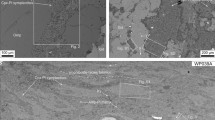Abstract.
The vesicularity, permeability, and structure of pumice clasts provide insight into conditions of vesiculation and fragmentation during Plinian fall and pyroclastic flow-producing phases of the ~7,700 cal. year B.P. climactic eruption of Mount Mazama (Crater Lake), Oregon. We show that bulk properties (vesicularity and permeability) can be correlated with internal textures and that the clast structure can be related to inferred changes in eruption conditions. The vesicularity of all pumice clasts is 75–88%, with >90% interconnected pore volume. However, pumice clasts from the Plinian fall deposits exhibit a wider vesicularity range and higher volume percentage of interconnected vesicles than do clasts from pyroclastic-flow deposits. Pumice permeabilities also differ between the two clast types, with pumice from the fall deposit having higher minimum permeabilities (~5×10–13 m2) and a narrower permeability range (5–50×10–13 m2) than clasts from pyroclastic-flow deposits (0.2–330×10–13 m2). The observed permeability can be modeled to estimate average vesicle aperture radii of 1–5 µm for the fall deposit clasts and 0.25–1 µm for clasts from the pyroclastic flows. High vesicle number densities (~109 cm–3) in all clasts suggest that bubble nucleation occurred rapidly and at high supersaturations. Post-nucleation modifications to bubble populations include both bubble growth and coalescence. A single stage of bubble nucleation and growth can account for 35–60% of the vesicle population in clasts from the fall deposits, and 65–80% in pumice from pyroclastic flows. Large vesicles form a separate population which defines a power law distribution with fractal dimension D=3.3 (range 3.0–3.5). The large D value, coupled with textural evidence, suggests that the large vesicles formed primarily by coalescence. When viewed together, the bulk properties (vesicularity, permeability) and textural characteristics of all clasts indicate rapid bubble nucleation followed by bubble growth, coalescence and permeability development. This sequence of events is best explained by nucleation in response to a downward-propagating decompression wave, followed by rapid bubble growth and coalescence prior to magma disruption by fragmentation. The heterogeneity of vesicle sizes and shapes, and the absence of differential expansion across individual clasts, suggest that post-fragmentation expansion played a limited role in the development of pumice structure. The higher vesicle number densities and lower permeabilities of pyroclastic-flow clasts indicate limited coalescence and suggest that fragmentation occurred shortly after decompression. Either increased eruption velocities or increased depth of fragmentation accompanying caldera collapse could explain compression of the pre-fragmentation vesiculation interval.
Similar content being viewed by others
Author information
Authors and Affiliations
Additional information
Electronic Publication
Rights and permissions
About this article
Cite this article
Klug, .C., Cashman, .K. & Bacon, .C. Structure and physical characteristics of pumice from the climactic eruption of Mount Mazama (Crater Lake), Oregon. Bull Volcanol 64, 486–501 (2002). https://doi.org/10.1007/s00445-002-0230-5
Received:
Accepted:
Issue Date:
DOI: https://doi.org/10.1007/s00445-002-0230-5




